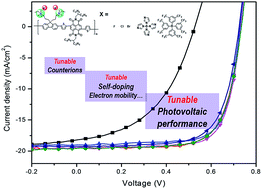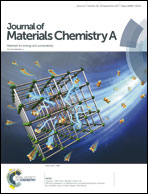Counterion-tunable n-type conjugated polyelectrolytes for the interface engineering of efficient polymer solar cells†
Abstract
N-type conjugated polyelectrolytes (CPEs) are promising electron transport materials (ETMs) in high-performance polymer solar cells (PSCs). The regulation of the counterions of CPEs can efficiently tune the properties of CPEs as well as their photovoltaic performance. In this contribution, we report a series of counterion-tunable n-type CPEs for the interface engineering of polymer solar cells, and the size, species and substituent groups of the counterions are discussed. The size of counterions had a great impact on the alcohol solubility and photophysical properties of CPEs. Besides, the self-doping behaviors of these CPEs are also highly correlated with their counterion species. Moreover, the charge transport and electrode modification study results show that the counterion species and their substituent groups are critical to the electron mobilities and electrode modification ability of these CPEs as well as their performance in PSCs. PSCs with these CPEs as ETMs can deliver high power conversion efficiency (PCE) up to 10.5%, and over 9.5% PCE can be maintained even when these CPEs are used as thick (80 nm) ETMs, indicating great potential of using these CPEs as thickness-insensitive ETMs for the fabrication of future large-area PSCs using roll-to-roll techniques.



 Please wait while we load your content...
Please wait while we load your content...